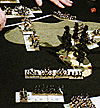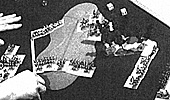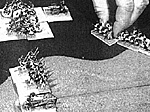Title: Le Petit Empereur
Designer: Chip Harrison
Designer's Credits: Age of Gunpowder (1995) and Fantasy Rules! (1996) miniatures rules published by his company, Chipco Games.
Number of Players: 2+
Playing Time: 1-2 hours
Complexity Level: Low; very good for beginners and non-wargamers.
Packaging: 10 pages of rules and army lists printed on cardstock, plus separate cover, in a plastic sleeve.
Scale: Strategic. Players control corps or small armies. Infantry and cavalry stands represent divisions. Artillery figures are either attached to these divisions, or stand alone as a grand battery.
Map: None; players can set up the playing field using the examples provided.
Playing Pieces: Two sheets of 40mm (1-1/2 inch) square cut-outs are provided which note the type of troops that square represents. The best visual presentation is to mount 15mm figures on 40mm bases.
Rules: Six 8-1/2-by-11-inch pages.
Not Included: Two 10-sided dice to keep track of the morale level for each side (called a "morale clock"), and at least one 6-sided die to resolve combat. You will also need a ruler or measuring tape, and casualty rings or other type of marker to indicate how many hits a unit has sustained.
Scenarios: A 7-page expansion pack with additional rules for light infantry, army lists for the 18th Century through the Seven Years War, and 10 Napoleonic and SYW scenarios is available. Chipco Expansion Pack #1 (CHCEP02-0695 $6.95).
Historical Background Information: There are no historical notes or bibliography. These rules allow for a very abstract representation of Napoleonic warfare. For example, one infantry stand cannot show it forms square against cavalry charges, but infantry are assumed to do so unless the army's morale level has decreased to a certain point. At that level, cavalry attacks begin having a greater impact. There are some slight nuances in the capabilities of troops of different nationalities. For example, Russian artillery has less chance of hitting compared to French artillery, but does more damage if it does hit.
Publisher: Chipco Games, 616 Spar Drive, Redwood City, CA 94065 (e-mail chameleo@ix.netcom or phone 415-595-5886 evenings).
Publication Date: 1995
Stock Number: CHNAP01-0895
List Price: $8.95
Summary: A simple, fast-playing set of miniatures rules that can be used to introduce someone to Napoleonic wargaming, or for experienced gamers to use for tournament play.
 At first glance, Le Petit Empereur (LPE) appeared to be very simple and too abstract to hold the interest of our wargaming group. However, playing the game proved to be much more fun than we anticipated.
At first glance, Le Petit Empereur (LPE) appeared to be very simple and too abstract to hold the interest of our wargaming group. However, playing the game proved to be much more fun than we anticipated.
This little set of rules could be especially useful for tournaments at conventions where a number of games must be played in a limited amount of time. In this regard, LPE is similar to the popular DBA rules (see box on page 52).
More importantly, LPE may be the first set of miniatures rules that can be used to introduce a beginner to Napoleonic wargaming.
This is so for three reasons. First, the game can be played without miniatures by using the cut-out bases provided. Second, if a novice is encouraged to buy miniatures, only 125 are needed per side--a modest investment, even if purchasing painted figures. Third, the rules are clear and simple, and an entire game can be played in about an hour, even with teams.
 Unlike other miniatures games with dozens of pages of rules (plus additional charts), LPE consists of three double-sided unbound sheets of rules, and three double-sided unbound pages with the summary of the sequence of play, movement, combat and fire charts, orders-of-battle and descriptive figures relating to the rule's text.
Unlike other miniatures games with dozens of pages of rules (plus additional charts), LPE consists of three double-sided unbound sheets of rules, and three double-sided unbound pages with the summary of the sequence of play, movement, combat and fire charts, orders-of-battle and descriptive figures relating to the rule's text.
There are seven different types of troops: Elite Infantry, Line Infantry, Light Infantry, Elite Cavalry, Other Cavalry, Artillery, and Light Artillery. Each side also has one General. Each troop type is mounted on one 40mm base. Up to 28 bases make an army, with the mix of troop types determined by the army's nationality. Although not stated in the rules, it is possible to adjust this mix by scenario or campaign year. For example, allow fewer bases per army for 1814 battles, or fewer French elite cavalry for late 1813 battles, etc.
 You can play LPE by using the cardboard cut-outs provided instead of miniatures. We mounted 15mm figures on 40mm bases, varying the number of figures per base to distinguish between the different types of troops. The rules also provide for using 25mm and 6mm figures as well. We were able to adapt our existing miniatures to LPE by using figures already mounted on bases for a different set of rules. Troop type and not the actual number of figures per base is what is used for combat.
You can play LPE by using the cardboard cut-outs provided instead of miniatures. We mounted 15mm figures on 40mm bases, varying the number of figures per base to distinguish between the different types of troops. The rules also provide for using 25mm and 6mm figures as well. We were able to adapt our existing miniatures to LPE by using figures already mounted on bases for a different set of rules. Troop type and not the actual number of figures per base is what is used for combat.
A playing field is only 36-by-48-inches for 15mm figures. We used a piece of green felt cut to this size, then placed the terrain objective--a single house representing a village on a 6-by-6-inch card in the middle of this playing area. Some trees and a hill completed the battlefield.
 A clever idea is the Morale Clock, a ten-sided die each side sets to the number nine at the start of the game. When your side loses a phase (there are two phases per turn), your Morale Clock is reduced by one. As your morale decreases, the number of corps and bases that are able to move also decreases. When either player's Morale Clock reaches zero, the game ends and both sides add up their points to determine the level of victory. Points are awarded for enemy bases eliminated, the enemy General eliminated, and for being in sole possession of the terrain objective.
A clever idea is the Morale Clock, a ten-sided die each side sets to the number nine at the start of the game. When your side loses a phase (there are two phases per turn), your Morale Clock is reduced by one. As your morale decreases, the number of corps and bases that are able to move also decreases. When either player's Morale Clock reaches zero, the game ends and both sides add up their points to determine the level of victory. Points are awarded for enemy bases eliminated, the enemy General eliminated, and for being in sole possession of the terrain objective.
Two or more bases make a corps. At the start of the game you must have a minimum of two and a maximum of four infantry corps and a minimum of one and a maximum of two cavalry corps. Artillery can be attached to these corps or act independently.
Combat uses a system comparing the type of troops firing/attacking to the type of troops defending. A certain die roll is needed to score a hit which, if successful, results in one "demoralization" step. Attacking a base on its flank at the same time it is locked in combat to its front increases the chances to score a demoralization. Three such demoralization hits and a base is eliminated. A base may also be forced to retreat.
When your Morale Clock is getting dangerously low, your General can attempt a "grand gesture" to try and increase the army's morale. Whether or not it works, the General is removed (but your opponent receives no points for this). If the General is attached to a base to help those troops, he can be eliminated if that base is eliminated.
 For this playtest, only one person initially read the rules. After a 30-minute explanation to the other three players, we started. Play moved quickly. We played six turns (twelve phases) in one hour and ten minutes. We did not play until the Morale Clock reached zero as it was obvious by the end of turn six what the outcome would be. We made a few minor mistakes (rather embarrassing for a group of experienced gamers using so few rules!), but none of these errors were critical.
For this playtest, only one person initially read the rules. After a 30-minute explanation to the other three players, we started. Play moved quickly. We played six turns (twelve phases) in one hour and ten minutes. We did not play until the Morale Clock reached zero as it was obvious by the end of turn six what the outcome would be. We made a few minor mistakes (rather embarrassing for a group of experienced gamers using so few rules!), but none of these errors were critical.
Le Petit Empereur has many subtleties that become apparent only through playing the game. Proper use of infantry, cavalry and artillery is rewarded. Support of a battle line with reserves at a proper distance is valuable (and decisive in our playtest). After learning these nuances in the first game, an immediate rematch was demanded!
Some improvements in play aids were suggested and are now provided, including a sheet repeating the movement and combat charts. These are printed on the back of the sequence of play chart, so having an extra sheet makes it easier to refer to all three tables as you play.
Despite the initial appearance that LPE does not offer much to excite an experienced Napoleonic wargamer, we had a great time and were pleasantly surprised by the game's simple yet artful mechanics of play. Le Petit Empereur does not teach the details and intricacies of Napoleonic tactics, but you may learn something of how armies fought. LPE is an excellent way to introduce someone to this colorful and dramatic period of history.
Back to Table of Contents -- Napoleon #3
© Copyright 1996 by Emperor's Press.
This article appears in MagWeb (Magazine Web) on the Internet World Wide Web.
The full text and graphics from other military history magazines and gaming magazines are available at http://www.magweb.com